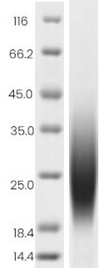Cavia Porcellus CD152 Protein, His Tag
-
产品编号
KMP2378
-
别名
细胞毒T淋巴细胞相关抗原, Cytotoxic T-lymphocyte protein 4, CD152
-
规格
- 50ug
- 100ug
- 200ug
| Catalog Number | KMP2378 |
| Alias | 细胞毒T淋巴细胞相关抗原, Cytotoxic T-lymphocyte protein 4, CD152 |
| Size | 50ug, 100ug, 200ug |
| Product Description | The Cavia Porcellus CD152 Protein(KMP2378) is produced in Yeast and the target gene encoding Ala37-Asp161 is expressed with a 6His tag at the C-terminus. |
| Molecular Name | CD152 |
| Product Introduction | CD152(CTLA-4):免疫调节受体,以跨膜形式表达于T细胞,参与免疫应答的负向调控。 |
| Molecular Weight | 14.56 kDa |
| Expression System | Yeast |
| Species | Cavia Porcellus |
| Purity | >90% |
| SDS-PAGE |  |
| Purification | Affinity Purification |
| Uniprot ID | H0VUB1 |
| Storage Condition | Aliquot and store at -20℃ to -80℃. Avoid repeated freezing and thawing cycles. |
| Formulation | PBS, pH7.4 |
| Shipping Condition | In general, the proteins are provided as lyophilized powder which are shipped at ambient temperature. They are shipped out in dry ice if supplied in liquid form. |
| Background | Cytotoxic Tlymphocyte 4(CTLA-4,CD152), is a type I transmembrane T cell inhibitory molecule that is a member of the Ig superfamily.CD28 and CTLA-4, together with their ligands, B7-1 and B7-2, constitute one of the dominant costimulatory pathways that regulate T and B cell responses. CD28 and CTLA-4 are structurally homologous molecules that are members of the immunoglobulin(Ig) gene superfamily. CTLA4 transmits an inhibitory signal to T cells, whereas CD28 transmits a stimulatory signal. Intracellular CTLA4 is also found in regulatory T Cells and may play an important role in their functions. Tcell activation through the Tcell receptor and CD28 leads to increased expression of CTLA4. |
| Endotoxin | <1.0 EU/ug determined by the LAL method |
| Product Declaration | 该产品仅供科研使用,不可直接用于人体或注射。 |
低速离心:12,000 rpm, 5分钟,去除不溶物。缓冲液置换:使用超滤离心管(如10 kDa截留分子量)浓缩。
可优化表达条件(如降低诱导温度、调整IPTG浓度)、使用促溶标签(如SUMO、GST)、共表达分子伴侣,或尝试不同宿主系统(如哺乳动物细胞或昆虫细胞)以提高可溶性蛋白产量。





 0
0
